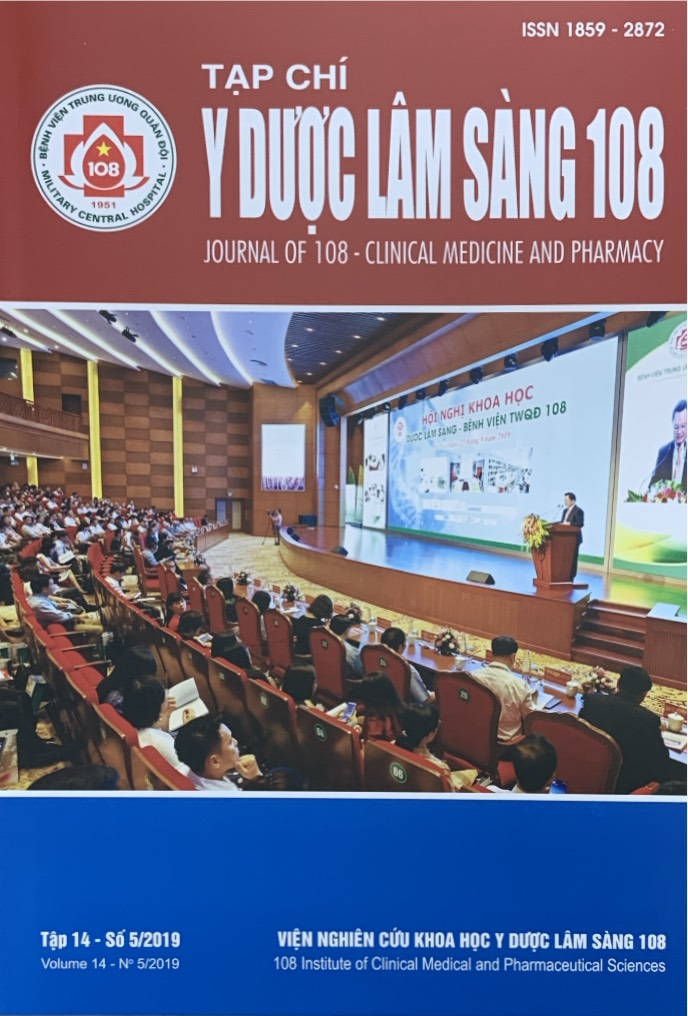Studying vasoactive-inotrop score after mitral valve replacement
Main Article Content
Keywords
Mitral valve replacement, vasoactive - inotrop score
Abstract
Objective: To evaluate on vasoactive - inotrop score (VIS) change and mortality rate predicted value of VIS after mitral valve replacement. Subject and method: Prospective, cross-sectional descriptive study was carried out on 67 mitral valve replacement patients. Calculation mean value of maximum VIS parameter in the first 24 hours after surgery and assess mortality predicted factors in hospital. Result and conclusion: Mean VISmax was 8.3, VISmax was significant different between complicated group and uncomplicated group after mitral valve replacement. Area under curve of VISmax was 0.997. Cut-off point value was 32.5 with Se 100% and Sp 98.4%. Area under curve of VISmax was a predicted factor in mortality after mitral valve replacement.
Article Details
References
1. Bộ Y tế (2014) Hướng dẫn quy trình kỹ thuật chuyên ngành Hồi sức - cấp cứu và chống độc, tr. 317-331
2 Garcia RU, Walters HL, Delius RE et al (2015) Vasoactive inotropic score (VIS) as biomarker of short-term outcomes in adolescents after cardiothoracic surgery. Pediatr Cardiol 37(2): 271-277.
3. Gaies MG, Jeffries HE, Niebler RA et al (2014) Vasoactive-inotropic score is associated with outcome after infant cardiac surgery: An analysis from the pediatric cardiac critical care consortium and virtual PICU system registries. Pediatr Crit Care Med 15(6): 529-537.
4. Koponen T, Karttunen J, Musialowicz T et al (2019) Vasoactive-inotropic score and the prediction of morbidity and mortality after cardiac surgery. Br J Anaesth 122(4): 428-436.
5. Bojar RM (2011) Perioperative care in aldult cardiac sugery, 5th ed. Wiley-Blackwell, West Sussex.
6. Lomivorotov VV, Efremov SM, Kirov MY et al (2017) Low cardiac output syndrome after cardiac surgery. Journal of cardiothorac vascular anesthesia 31(1): 291-308.
7. Nashef SAM, Roques F, Michel P et al (1999) European system for cardiac operative risk evaluation (EuroSCORE). European Journal of Cardio-thoracic Surgery: 169-213.
8. Poterucha JT, Vallabhajosyula S, Egbe AC et al (2019) Vasopressor magnitude predicts poor outcome in adults with congenital heart disease after cardiac surgery. Congenit Heart Dis 14(2): 193-200.
9. Kim JW, Gwak M, Shin WJ et al (2015) Preoperative factors as a predictor for early postoperative outcomes after repair of congenital transposition of the great arteries. Pediatr Cardiol 36(3): 537-542.
10. Rudolph AM (2009) Congenital diseases of the heart: Clinicalphysiological considerations, 3rd ed. Wiley, Chichester, Hoboken.
2 Garcia RU, Walters HL, Delius RE et al (2015) Vasoactive inotropic score (VIS) as biomarker of short-term outcomes in adolescents after cardiothoracic surgery. Pediatr Cardiol 37(2): 271-277.
3. Gaies MG, Jeffries HE, Niebler RA et al (2014) Vasoactive-inotropic score is associated with outcome after infant cardiac surgery: An analysis from the pediatric cardiac critical care consortium and virtual PICU system registries. Pediatr Crit Care Med 15(6): 529-537.
4. Koponen T, Karttunen J, Musialowicz T et al (2019) Vasoactive-inotropic score and the prediction of morbidity and mortality after cardiac surgery. Br J Anaesth 122(4): 428-436.
5. Bojar RM (2011) Perioperative care in aldult cardiac sugery, 5th ed. Wiley-Blackwell, West Sussex.
6. Lomivorotov VV, Efremov SM, Kirov MY et al (2017) Low cardiac output syndrome after cardiac surgery. Journal of cardiothorac vascular anesthesia 31(1): 291-308.
7. Nashef SAM, Roques F, Michel P et al (1999) European system for cardiac operative risk evaluation (EuroSCORE). European Journal of Cardio-thoracic Surgery: 169-213.
8. Poterucha JT, Vallabhajosyula S, Egbe AC et al (2019) Vasopressor magnitude predicts poor outcome in adults with congenital heart disease after cardiac surgery. Congenit Heart Dis 14(2): 193-200.
9. Kim JW, Gwak M, Shin WJ et al (2015) Preoperative factors as a predictor for early postoperative outcomes after repair of congenital transposition of the great arteries. Pediatr Cardiol 36(3): 537-542.
10. Rudolph AM (2009) Congenital diseases of the heart: Clinicalphysiological considerations, 3rd ed. Wiley, Chichester, Hoboken.
 ISSN: 1859 - 2872
ISSN: 1859 - 2872
